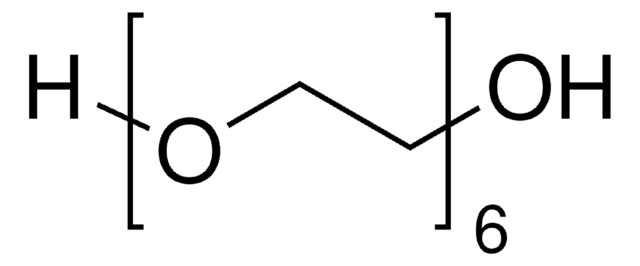8.08245
Triethylene glycol
for synthesis
Sinónimos:
Triethylene glycol, Triglycol
About This Item
Productos recomendados
vapor pressure
<0.01 hPa ( 20 °C)
Quality Level
assay
≥99% (GC)
form
liquid
autoignition temp.
370 °C
potency
17000 mg/kg LD50, oral (Rat)
>5000 mg/kg LD50, skin (Rat)
expl. lim.
0.9-9.2 % (v/v)
pH
6.5-7.5 (20 °C, 100 g/L in H2O)
bp
285-295 °C/1013 hPa
mp
-7 °C
transition temp
flash point 165 °C
density
1.123 g/cm3 at 20 °C
storage temp.
2-30°C
InChI
1S/C6H14O4/c7-1-3-9-5-6-10-4-2-8/h7-8H,1-6H2
InChI key
ZIBGPFATKBEMQZ-UHFFFAOYSA-N
Application
- Elucidating the Role of Reduction Kinetics in the Phase-Controlled Growth on Preformed Nanocrystal Seeds: A Case Study of Ru: This study explores the phase-controlled growth of ruthenium nanocrystals using triethylene glycol as a reducing agent, providing insights into the kinetics of nanomaterial synthesis for catalytic applications (Nguyen et al., 2024).
- Deep Eutectic Solvents as Agents for Improving the Solubility of Edaravone: Experimental and Theoretical Considerations: This research investigates the use of deep eutectic solvents, including those formulated with triethylene glycol, to enhance the solubility of edaravone. The findings demonstrate significant improvements in drug solubility and bioavailability (Jeliński et al., 2024).
- Probing the evaporation dynamics of semi-volatile organic compounds to reveal the thermodynamics of liquid-liquid phase separated aerosol: This study uses triethylene glycol in experiments to understand the evaporation dynamics and thermodynamics of semi-volatile organic compounds in liquid-liquid phase-separated aerosols. The research provides valuable data for atmospheric chemistry and environmental science (Choczynski et al., 2024).
Analysis Note
Density (d 20 °C/ 4 °C): 1.123 - 1.124
Water (K. F.): ≤ 0.30 %
Identity (IR): passes test
Storage Class
10 - Combustible liquids
wgk_germany
WGK 1
flash_point_f
330.8 °F - closed cup
flash_point_c
166 °C - closed cup
Certificados de análisis (COA)
Busque Certificados de análisis (COA) introduciendo el número de lote del producto. Los números de lote se encuentran en la etiqueta del producto después de las palabras «Lot» o «Batch»
¿Ya tiene este producto?
Encuentre la documentación para los productos que ha comprado recientemente en la Biblioteca de documentos.
Los clientes también vieron
Nuestro equipo de científicos tiene experiencia en todas las áreas de investigación: Ciencias de la vida, Ciencia de los materiales, Síntesis química, Cromatografía, Analítica y muchas otras.
Póngase en contacto con el Servicio técnico









